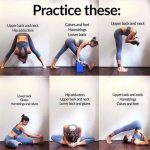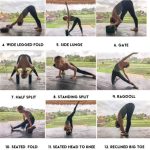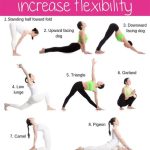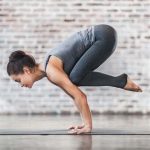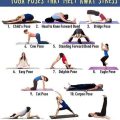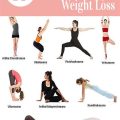Unlocking Flexibility: The Best Yoga Flow for Tight Muscles
Yoga has long been regarded as one of the most effective practices for increasing flexibility, relieving muscle tension, and promoting overall well-being. For individuals with tight muscles, finding the right yoga flow can make a profound difference. In this guide, we’ll explore the most effective yoga practices to release tightness, restore mobility, and support your body’s natural alignment. This flow will target common areas of tension—hips, hamstrings, shoulders, and lower back—while promoting flexibility and relaxation.
Introduction: Understanding Muscle Tightness and Yoga’s Role in Flexibility
Tight muscles can stem from a range of causes, including sedentary lifestyles, overuse, or even stress. This restriction often leads to discomfort, limited mobility, and an increased risk of injury. Yoga, however, offers a holistic solution by combining movement with breathwork, helping to lengthen and release muscles, restore balance, and enhance flexibility. In this article, we’ll focus on a yoga flow specifically designed to address and alleviate muscle tightness, while discussing the broader benefits of regular practice for flexibility and muscular health.
Key Concepts in Addressing Muscle Tightness Through Yoga
To create an effective yoga flow for tight muscles, it’s important to first understand the key concepts that guide the practice:
- Stretch Reflex: A natural response where muscles contract to protect against overstretching. Yoga encourages gradual muscle relaxation to prevent overstretching.
- Active Stretching: Involves engaging muscles while stretching, which increases flexibility over time.
- Breath and Movement Synchronization: Linking breath with movement promotes relaxation and helps release tension.
- Consistency: Regular practice is essential for long-term flexibility improvements.
- Mind-Body Connection: Yoga emphasizes the connection between mental calmness and physical release, which aids in muscle relaxation.
Historical Context: Yoga’s Evolution as a Tool for Flexibility
Yoga has its roots in ancient India, where it was traditionally practiced to unify the body, mind, and spirit. Initially a spiritual practice, it evolved into a multifaceted approach to health. Over centuries, yoga postures (asanas) have been adapted to promote physical benefits, such as flexibility and muscle relaxation. While yoga was historically intertwined with meditation, it now occupies a vital role in physical fitness and rehabilitation, particularly for those seeking relief from muscle tension.
Current State Analysis: The Science Behind Yoga and Muscle Flexibility
Scientific studies have repeatedly shown that yoga is beneficial for improving muscle flexibility and range of motion. It works by targeting muscle groups prone to tightness, such as the hamstrings, lower back, and shoulders. The practice of holding poses and using controlled breathing techniques promotes muscle lengthening, reduces the stretch reflex, and enhances muscle elasticity over time.
For individuals with chronically tight muscles, yoga can also aid in injury prevention by loosening tight areas and strengthening surrounding muscle groups, creating a balanced and supportive framework for the body.
Practical Applications: A Targeted Yoga Flow for Tight Muscles
The following yoga flow is designed to stretch and release commonly tight muscle groups while increasing flexibility and relaxation:
- Cat-Cow Pose (Marjaryasana-Bitilasana): Helps to release tension in the spine and warms up the back muscles.
- Downward Facing Dog (Adho Mukha Svanasana): Stretches the hamstrings, calves, and shoulders while lengthening the spine.
- Forward Fold (Uttanasana): Targets the hamstrings and lower back.
- Low Lunge (Anjaneyasana): Stretches the hip flexors and quadriceps.
- Pigeon Pose (Eka Pada Rajakapotasana): Opens the hips and glutes, relieving tension.
- Seated Forward Bend (Paschimottanasana): Focuses on the hamstrings and lower back.
- Reclined Twist (Supta Matsyendrasana): Releases tension in the spine and lower back.
- Child’s Pose (Balasana): Provides a gentle stretch for the lower back and hips, while promoting relaxation.
Case Studies: How Regular Yoga Practice Improves Flexibility
Many individuals have seen significant improvements in flexibility and reduction in muscle tightness through consistent yoga practice. Below are some notable examples:
| Case Study | Initial Condition | Yoga Routine | Results |
|---|---|---|---|
| Athlete with Tight Hamstrings | Severe tightness, limited mobility | Weekly yoga flow focusing on hamstrings and hip flexors | Improved hamstring flexibility, fewer injuries |
| Office Worker with Lower Back Pain | Chronic tightness in the lower back from prolonged sitting | Daily 20-minute yoga practice targeting spine and hips | Reduction in back pain, increased mobility |
| Sedentary Adult with Shoulder Tightness | Restricted shoulder movement, chronic pain | Twice-weekly yoga sessions with shoulder-focused stretches | Improved range of motion, pain relief |
Stakeholder Analysis: Who Benefits from Yoga for Tight Muscles?
Yoga for tight muscles offers significant benefits for various stakeholders, including:
- Athletes: Improved flexibility, reduced injury risk.
- Office Workers: Relief from tension caused by prolonged sitting.
- Older Adults: Enhanced mobility and reduced stiffness.
- Yoga Instructors: Opportunity to offer specialized classes targeting tight muscles.
- Healthcare Professionals: Yoga as a recommended practice for rehabilitation and flexibility.
Implementation Guidelines: Integrating Yoga for Flexibility into Daily Life
For optimal results, the following guidelines can help you incorporate yoga into your routine:
- Consistency: Practice 3-4 times per week for 20-30 minutes.
- Warm-Up: Always start with a gentle warm-up to prepare muscles.
- Listen to Your Body: Avoid forcing stretches; focus on gradual improvement.
- Breathing: Synchronize deep, mindful breathing with movement to aid muscle relaxation.
- Rest Days: Allow muscles to recover with rest or gentler yoga sessions.
Ethical Considerations: The Balance Between Flexibility and Safety
While yoga is highly beneficial, it’s important to maintain ethical practices to avoid injury or excessive strain. Encouraging students or practitioners to prioritize safety over extreme flexibility is essential. Teachers should emphasize mindful progress, particularly when working with beginners or individuals with pre-existing conditions.
Limitations and Future Research
While yoga has proven effective for improving flexibility and relieving muscle tension, some limitations remain. The practice’s impact on individuals with chronic or severe muscle tightness may require additional research. Moreover, further studies are needed to assess the long-term benefits of yoga across diverse populations. Future research could also explore combining yoga with other modalities, such as physical therapy or strength training, to create even more effective approaches for flexibility.
Expert Commentary
Experts agree that yoga is one of the best tools for increasing flexibility and reducing muscle tension. Its ability to adapt to different body types and levels of flexibility makes it a highly versatile practice. While it may take time for results to become noticeable, consistent practice leads to long-lasting changes in muscle elasticity, mobility, and overall well-being. The most important aspect is to approach yoga with patience, mindfulness, and a commitment to gradual improvement.
Unlock the Power of Daily Yoga to Improve Your Flexibility
Yoga has long been known for its mental, physical, and emotional benefits. One of the most sought-after outcomes of a regular yoga practice is increased flexibility. Whether you’re an athlete looking to enhance performance or simply someone wanting to feel more limber in daily life, incorporating yoga into your routine can have profound effects. In this comprehensive guide, we’ll explore how daily yoga can enhance your flexibility, offer practical examples of poses that target different muscle groups, and provide strategies to get started with an adaptable and effective practice.
Introduction
In today’s fast-paced world, flexibility is often overlooked as a crucial component of overall health. Yet, it plays a key role in reducing injuries, alleviating pain, and improving posture. While flexibility may not be the first thing you think of when you start practicing yoga, it quickly becomes a natural side effect of daily movement, mindfulness, and stretching. But how exactly does yoga improve flexibility? What are the best practices to follow, and which poses are particularly effective for stretching out specific muscles? We’ll break down these questions in detail to offer both newcomers and experienced practitioners practical insights into improving flexibility with yoga.
Key Concepts
- Flexibility: The ability of muscles and joints to move through their full range of motion.
- Range of Motion (ROM): The degree to which a joint can move before being restricted by surrounding tissues.
- Stretch Reflex: A muscle’s reaction to being stretched too quickly, causing it to contract. Yoga works to gradually increase flexibility and reduce this reflex.
- Breathwork (Pranayama): Yogic breathing techniques that assist in lengthening muscles and improving mind-body connection.
Historical Context
Yoga dates back over 5,000 years, originating in ancient India. Initially developed as a spiritual practice, the physical aspects of yoga (known as asanas) have evolved and expanded over the centuries. Flexibility, while not the primary goal in traditional yoga, was always an essential element, as a flexible body was considered a prerequisite for a meditative and spiritually focused mind. Over time, with the rise of modern yoga practices, flexibility has become one of the focal points for many practitioners seeking physical benefits.
Current State Analysis
In the modern fitness landscape, yoga is seen as a comprehensive approach to wellness. More than ever, people are turning to yoga to improve not just flexibility, but also strength, endurance, and mental clarity. Studies show that consistent yoga practice can increase flexibility by as much as 35-40% over time, depending on the individual’s starting point. Many styles of yoga, such as Hatha, Vinyasa, and Yin Yoga, emphasize stretches that target major muscle groups, making yoga an accessible and effective method for enhancing flexibility.
Practical Applications
To get the most out of your yoga practice and improve flexibility, consistency is key. Here are some practical steps to incorporate daily yoga into your routine:
- Start Small: If you’re new to yoga, begin with short 10-15 minute sessions focusing on key muscle groups.
- Focus on Breath: Deep breathing helps relax muscles and allows for a deeper stretch.
- Use Props: Blocks, straps, and bolsters can support you in poses that may initially feel inaccessible.
- Be Patient: Flexibility takes time, so honor your body’s current abilities and avoid overstretching.
Case Studies
To illustrate how daily yoga can improve flexibility, we’ll look at three real-world examples:
- Case Study 1 – Sarah, Office Worker: Sarah spends 8 hours a day sitting at her desk, leading to tight hips and hamstrings. After incorporating 20 minutes of yoga into her daily routine, focusing on Forward Folds and Pigeon Pose, she noticed a significant reduction in stiffness within 6 weeks.
- Case Study 2 – Mark, Amateur Athlete: Mark added yoga to his training regime to prevent injuries. Practicing Downward Dog and Warrior I helped improve his range of motion, resulting in a 25% increase in flexibility over a 3-month period.
- Case Study 3 – Anna, Senior Citizen: At 65, Anna wanted to maintain her mobility. By practicing gentle yoga poses like Cat-Cow and Seated Forward Bend, she was able to improve her joint flexibility and reduce lower back pain.
Stakeholder Analysis
Various groups can benefit from increased flexibility through daily yoga, each with unique needs and challenges:
| Stakeholder | Key Benefits | Challenges |
|---|---|---|
| Athletes | Increased range of motion, injury prevention | Balancing yoga with strength training |
| Office Workers | Reduced stiffness, better posture | Finding time for practice |
| Seniors | Maintaining mobility, reducing joint pain | Accessibility of poses |
Implementation Guidelines
To successfully incorporate daily yoga for flexibility, follow these guidelines:
- Set a Schedule: Dedicate a specific time each day for your yoga practice to build consistency.
- Choose Poses Based on Your Needs: Tailor your practice to target the areas where you feel the most tension, such as Bridge Pose for hips or Child’s Pose for the lower back.
- Incorporate Restorative Yoga: Include restorative yoga sessions that emphasize longer holds to deeply stretch muscles.
Ethical Considerations
As with any fitness regime, it’s essential to approach yoga with mindfulness and a respect for your body’s limitations. Overstretching or forcing flexibility can lead to injury. The practice of yoga should always prioritize safety and personal well-being over achieving a particular pose.
Limitations and Future Research
While yoga has been shown to improve flexibility, it’s important to recognize its limitations. Factors such as age, genetics, and pre-existing conditions can affect how much flexibility an individual can gain. More research is needed to understand the long-term impacts of yoga on flexibility across different demographics, including those with chronic pain or mobility issues.
Expert Commentary
Experts agree that daily yoga can be transformative in improving flexibility. However, they stress the importance of gradual progress, avoiding over-exertion, and complementing yoga with other forms of physical activity. As yoga continues to evolve, future trends may include more personalized programs tailored to individual flexibility needs, with emerging technology allowing practitioners to track and improve their progress in real-time.


